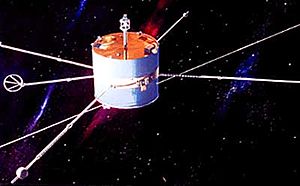SCATHA
| SCATHA | |
|---|---|

|
|
| Type: | Research satellite |
| Country: |
|
| Operator: | US Air Force |
| COSPAR-ID : | 1979-007A |
| Mission dates | |
| Dimensions: | 360 kg |
| Size: | 1.7 m diameter, 1.8 m height |
| Begin: | January 30, 1979, 21:42 UTC |
| Starting place: | Cape Canaveral LC 17B |
| Launcher: | Delta 2914 629 / D148 |
| Status: | inactive |
| Orbit data | |
| Rotation time : | 1416 min |
| Orbit inclination : | 8.3 ° |
| Apogee height : | 42,000 km |
| Perigee height : | 28,000 km |
Scatha ( S pace craft C harging at H igh A ltitude) or P78-2 was a research satellite of the United States Air Force , the January 30, 1979 at 21:42 UTC with a Delta 2914 from Launch Complex 17 B of Cape Canaveral Air Force Station in an elliptical transfer orbit between 185 km and almost 44,000 km altitude with 28 ° inclination to the equator. From there, SCATHA reached a quasi-stationary orbit with its own drive by April 1, 1979 at an altitude of about 28,000 km to about 42,000 km with an inclination of about 8.0 ° to the equator. It was the 148th launch of a Delta rocket.
SCATHA was launched to study the formation of electrical charges on satellites in the Earth's magnetosphere, which can lead to destructive electrical discharges. To this end, SCATHA also examined the earth's magnetosphere. It should also be determined how satellites can be protected against discharges.
SCATHA was a spin-stabilized , drum-shaped satellite built by Martin Marietta , 1.7 m in diameter and 1.8 m in height. SCATHA had three booms 3 m long, one 2 m long and one 7 m long. The top and bottom of SCATHA's coat were covered with solar cells. Fold-out booms were attached to the middle area and when folded up, they pointed upwards or downwards when they took off. The arms unfolded into the equatorial plane of SCATHA so that they were perpendicular to the spin axis. At the center of the top of SCATHA was an antenna through which the SCATHA's axis of rotation ran. There was also an extendable rod antenna that was extended parallel to the booms and is 101.7 m long from one end to the other. SCATHA rotates around its own axis at 1 rev / min for stabilization and has eight correction drives that are supplied with hydrazine from two tanks . The solar cells generate 290 watts, and the data transmission took place in the S-band. The 360 kg SCATHA satellite carried 12 scientific experiments with a total weight of 87 kg on board. These consume 110 watts of electrical power. The one-year mission could be extended to almost ten years, although two of the experiments were canceled shortly after activation.
Main sources
- SCATHA (P78-2) on Gunter's Space Page (English)
- SCATHA in the Encyclopedia Astronautica (English)
Web links
- Spacecraft Charging AT High Altitude (SCATHA) ( Memento from June 19, 2001 in the Internet Archive ) (English)
- Data Recovery From SCATHA Satellite ( Memento from March 4, 2016 in the Internet Archive ) (PDF, 5 MB, 204 pages, English)
- SCATHA Environmental Atlas PDF 5.5 MB (English)
- JPL Mission and Spacecraft Library: SCATHA, Spacecraft Charging at High Altitude (English)
- Articles about Spacecraft Charging (English)
- The Encyclopedia of Science: SCATHA (Spacecraft Charging At High Altitudes )
Individual evidence
- ↑ a b STP P78-2 in the NSSDCA Master Catalog , accessed on February 13, 2012 (English).
- ↑ The RAE Tables of artificial satellites: 1979 ( MS Word ; 196 kB)
- ^ B. Stanek: Raumfahrtlexikon , Halwag Verlag, Bern (1983), ISBN 3-444-10288-7, page: 69
- ^ Spacecraft Charging. (PDF) In: Crosslink Winter 2008/2009. The Aerospace Corporation, 2008, p. 18 , archived from the original on November 14, 2017 ; accessed on June 12, 2014 (English, see picture).
- ↑ George Paulikas: The Aerospace Laboratories: 50 Years of Science in Support of National Security Space. In: Crosslink Volume 11, Number 1. The Aerospace Corporation, 2010, archived from the original on November 14, 2017 ; accessed on June 12, 2014 .